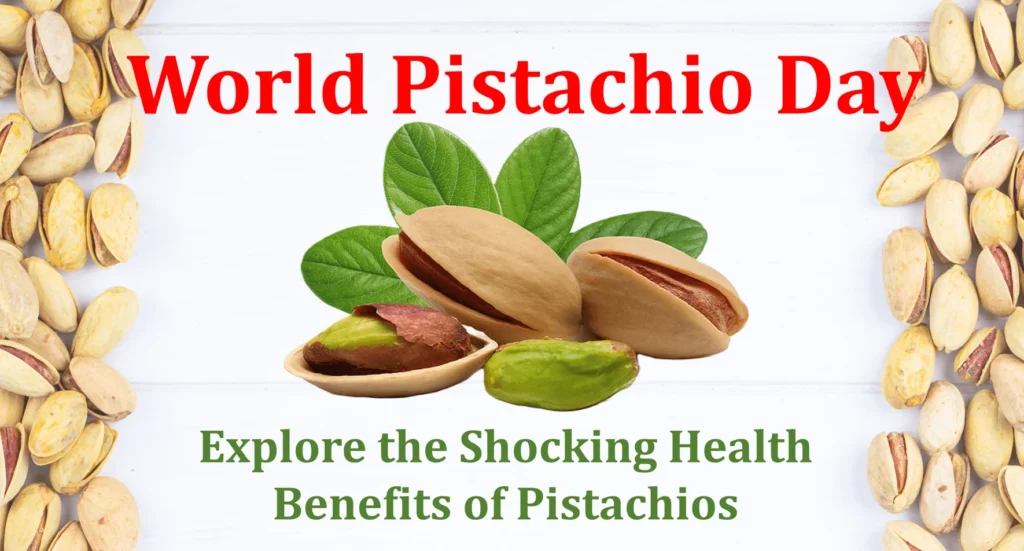
Introduction
Pistachios have long been celebrated for their distinctive flavor and crunchy texture, but did you know that they also offer a multitude of health benefits? Today, we dive into the world of pistachios as we commemorate World Pistachio Day on February 26th. This annual event serves as a reminder of the nutritional powerhouse that these nuts truly are.
Origins of World Pistachio Day
World Pistachio Day traces its roots back to the United States, where the Pistachio Health Institute first established the celebration in 2012. This initiative aimed to raise awareness about the health benefits of pistachios and highlight the importance of incorporating them into a balanced diet. Since then, the observance has gained international recognition, with people from all corners of the globe joining in the festivities.
Importance and Global Observance
The significance of this day lies in its role as a platform for promoting healthy eating habits and showcasing the nutritious qualities of pistachios. From California to the Middle East, this event serves as a reminder to consumers worldwide that these nuts are not only delicious but also packed with essential nutrients like protein, fiber, and antioxidants. In countries where they are a staple crop, this day holds special significance, fostering a sense of pride in their local produce.
Traditions and Festivities Surrounding the Day
On World Pistachio Day, various activities and events are organized to celebrate the humble pistachio. From cooking demonstrations to recipe contests, enthusiasts come together to share their love for this versatile nut. In some regions, it is customary to gift them to friends and family as a symbol of good luck and prosperity. These traditions not only highlight the cultural significance but also serve as a reminder of their value beyond just a snack.
History and Significance of World Pistachio Day
Origins and Cultivation of Pistachio Trees
Scientifically known as Pistacia vera, have a rich and ancient history that traces back thousands of years. Believed to have originated in the regions of Central Asia and the Middle East, their trees have been cultivated for their delicious nuts since prehistoric times.
- Origins: This tree is a member of the cashew family and is native to the arid climates of the Middle East and Central Asia, particularly Iran, Iraq, and Turkey. These regions provide the ideal conditions for their cultivation, with hot summers, cold winters, and well-drained soil.
- Cultivation: Historically, these trees were primarily grown in the Middle East, where they thrived in the rocky, desert like terrain. The cultivation requires patience, as these trees take several years to mature and produce a significant yield of nuts. Today, they are also grown in other parts of the world, including the United States, Greece, and Italy.
Historical Significance of Pistachios in Various Cultures
They hold a special place in the cultural and culinary traditions of many civilizations throughout history. From ancient times to the present day, they have been revered for their unique flavor, nutritional value, and symbolic significance.
- Ancient Civilizations: Their consumption dates back to ancient times, with evidence of their use found in archaeological sites dating over 9,000 years ago. In civilizations such as Ancient Greece, Rome, and Persia, they were considered a luxurious delicacy enjoyed by royalty and the elite.
- Symbolism: They have been associated with various symbols and meanings across different cultures. In some traditions, they are seen as a symbol of prosperity, abundance, and good fortune. They are often included in festive celebrations and rituals to bring luck and blessings to the participants.
Evolution of Pistachio Farming and Trade
The cultivation and their trade have undergone significant transformations over the centuries, driven by advancements in agricultural practices, technology, and global commerce.
- Traditional Farming Methods: Historically, they were harvested manually using traditional methods, with farmers carefully tending to their orchards and handpicking the ripe nuts. These labor-intensive techniques limited the scale of their production and distribution.
- Modern Farming Practices: In recent decades, advancements in agricultural science and technology have revolutionized its farming. Modern orchards utilize irrigation systems, mechanized harvesting equipment, and innovative growing techniques to increase efficiency and yield.
- Global Trade: The demand for pistachios has surged in the global market, leading to increased trade and investment in its producing regions. Countries like Iran, the United States, and Turkey are among the leading exporters of pistachios, catering to consumers worldwide.
- Sustainability Efforts: With growing concerns about environmental sustainability, many pistachio growers are adopting ecofriendly practices to minimize water usage, reduce carbon emissions, and preserve natural habitats.
Their history and significance are deeply intertwined with the cultural heritage, culinary traditions, and agricultural practices of societies around the world. World Pistachio Day serves as a celebration of this cherished nut and its enduring legacy across generations.
Varieties of Pistachios
Exploring the diverse world of pistachios unveils a tapestry of flavors, sizes, and qualities. Let’s delve into the different types of pistachios, each offering a unique taste and experience.
- Fandoghi (Iranian Round Pistachio): The Iranian Round Pistachio, also known as Fandoghi, enjoys widespread popularity and is likely a familiar choice for many. Cultivated extensively in Iran, it’s recognized for its rounded shape and increasing demand. However, its cultivation demands substantial planting efforts, prompting some growers to explore alternative varieties.
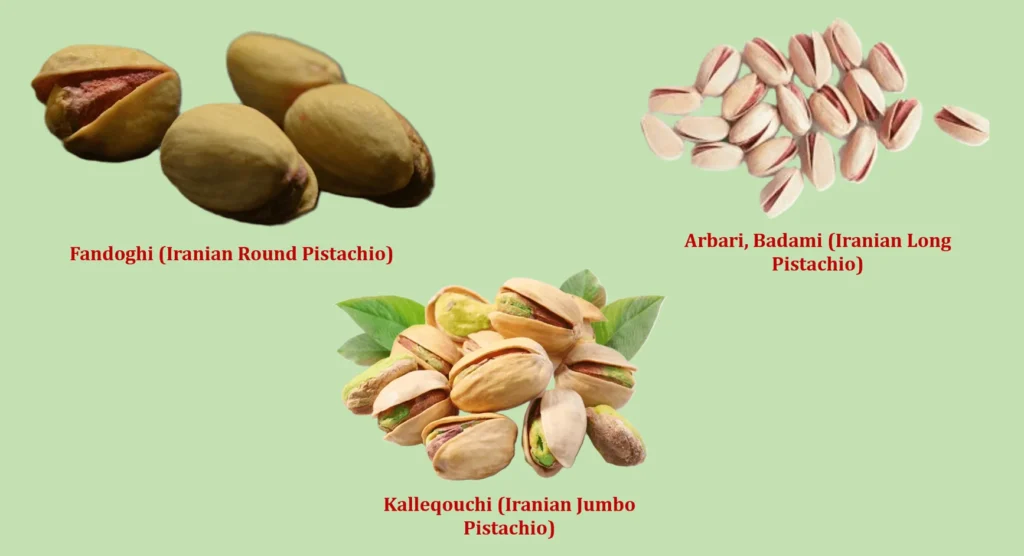
- Kalleqouchi (Iranian Jumbo Pistachio): Noteworthy for its impressive size, the Iranian Jumbo Pistachio stands out among its counterparts. Its substantial dimensions command attention, though its vulnerability to cold weather and water scarcity poses challenges for growers. Despite its premium quality, its cultivation is dwindling due to aging plants and challenging maintenance.
- Arbari, Badami (Iranian Long Pistachio): With its elongated form and lighter shell, the Iranian Long gains popularity year by year. Harvested in late September, its robust crops signal success for their farmers. While not as large as the Jumbo variety, it offers a satisfyingly sized nut prized for its taste and texture.
- Akbari (Persian Elongated Pistachios): Renowned for their elongated shape and rich nutty flavor, Persian Elongated Pistachios, also known as Akbari, are a preferred choice for health-conscious consumers. With a higher unsaturated fat content, they offer a flavorful and nutritious snack option.
- Green Skinned Pistachio: The Green Skinned Pistachio, often termed shelled raw pistachios, presents convenience with its shell free appeal. Ready to eat and easy to season or roast, they offer a hassle-free snacking experience and culinary flexibility.

- Turkish Antep Pistachios: Hailing from Turkey, Turkish Antep Pistachios boast exceptional quality and nutritional benefits. Despite their smaller size and challenging shell, they are cherished by enthusiasts for their rich taste and energy boosting properties.
- Kernel Pistachio: Kernel Pistachios, comprising pieces from closed nuts, are ideal for culinary adventures. Their smaller size and broken forms make them perfect for cooking, roasting, or baking, offering versatility and flavor in various dishes.
- Red Pistachios: Once a decorative delight, Red Pistachios are now a rarity, dyed to conceal imperfections on their shells. Though their appearance may differ, their taste remains unaffected, making them a visually appealing addition to any spread.
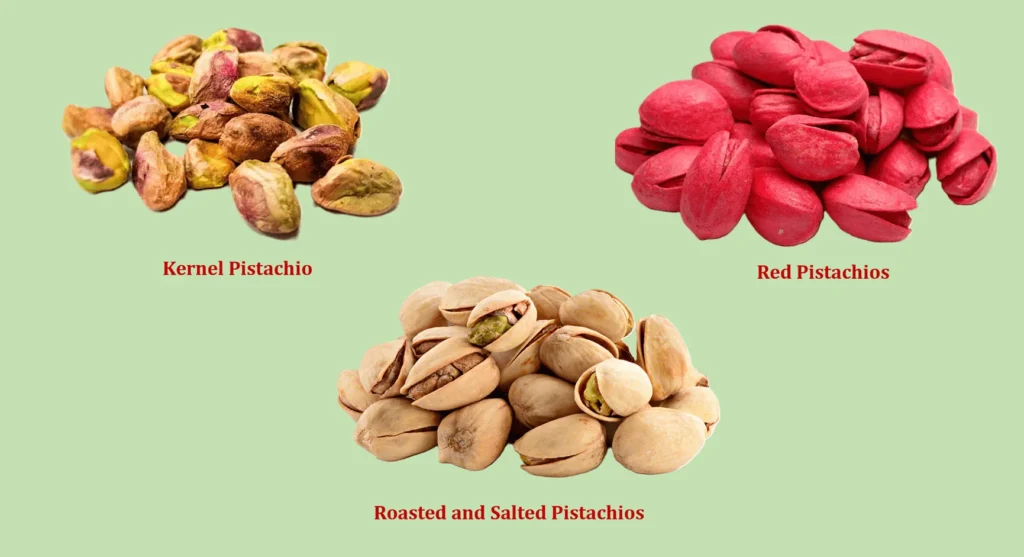
- Roasted and Salted Pistachios: A treat for the taste buds, Roasted and Salted Pistachios tantalize with their savory flavors and crunchy texture. While convenient for entertaining and snacking, they come with a premium price tag due to the meticulous process involved in their preparation.
In essence, it has a mosaic of flavors and textures, each variety offering a distinct gustatory experience. Whether enjoyed as a wholesome snack or incorporated into culinary creations, they continue to captivate and delight aficionados around the globe.
Health Benefits of Pistachios
Nutrient Profile and Major Health Benefits
- Heart Health Benefits:
- They are rich in heart healthy monounsaturated and polyunsaturated fats, which can help lower LDL (bad) cholesterol levels and reduce the risk of heart disease.
- They also contain significant amounts of potassium, which helps regulate blood pressure and improve cardiovascular function.
- Weight Management Benefits:
- Despite being calorie dense, they are a great choice for weight management due to their high protein and fiber content.
- The protein and fiber in them help increase feelings of fullness and satiety, which can prevent overeating and promote weight loss.
- Blood Sugar Control Benefits:
- They have a low glycemic index, meaning they cause a slower and steadier rise in blood sugar levels compared to high glycemic foods.
- The combination of protein, healthy fats, and fiber in them helps stabilize blood sugar levels and reduce the risk of insulin resistance and type 2 diabetes.
Antioxidant Properties and Immune Boosting Effects
- Benefit for Eye Health:
- They are a good source of antioxidants such as lutein and zeaxanthin, which are beneficial for eye health.
- These antioxidants help protect the eyes from age-related macular degeneration and reduce the risk of cataracts.
- Benefit for Skin Health:
- The antioxidants found in them, along with their vitamin E content, help protect the skin from oxidative damage caused by free radicals.
- Regular consumption of this nut may contribute to healthier, more youthful looking skin and may help prevent signs of aging.
- Benefit for Gut Health:
- They contain fiber, which acts as a prebiotic and helps promote the growth of beneficial bacteria in the gut.
- A healthy balance of gut bacteria is essential for proper digestion, immune function, and overall wellbeing.
Potential Risks and Precautions
While they offer numerous health benefits, they may pose risks for individuals with nut allergies. It’s essential for those with allergies to avoid them and their products to prevent allergic reactions. They are calorie dense, so portion control is crucial, especially for individuals watching their calorie intake or trying to lose weight. Some people may experience digestive discomfort or allergic reactions to them. It’s important to monitor how your body responds to them and consult a healthcare professional if you have any concerns.
They are not only delicious but also offer a wide range of health benefits, from promoting heart health and weight management to supporting immune function and skin health. However, it’s essential to consume them in moderation and be mindful of any potential risks or allergies. Incorporating them into a balanced diet can be a flavorful and nutritious way to support overall health and wellbeing.
Culinary Uses of Pistachios
Sweet and Savory Uses in Different Cuisines
Pistachios in Baking and Desserts
- They add a delightful nutty flavor and crunchy texture to a variety of desserts such as cakes, cookies, pastries, and ice creams.
- They are commonly used as a topping for desserts like baklava, biscotti, and pistachio ice cream, adding both visual appeal and a rich flavor profile.
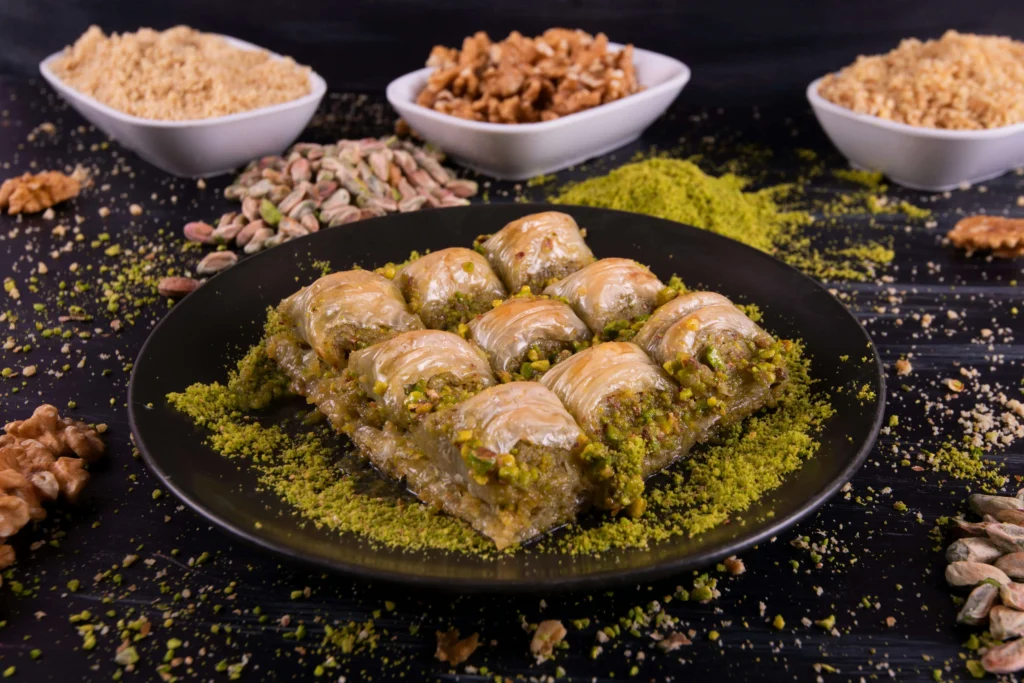
Pistachios in Salads and Main Courses
- In savory dishes, they can be used to add texture and flavor to salads, pilafs, rice dishes, and pasta.
- They pair well with ingredients like goat cheese, citrus fruits, grilled vegetables, and roasted meats, enhancing the overall taste and presentation of the dish.
Pistachios in Snacks and Appetizers
- Roasted and salted pistachios make a delicious and nutritious snack on their own.
- They can also be incorporated into appetizers such as cheese platters, bruschetta, and stuffed mushrooms, providing a crunchy contrast to creamy or savory components.
Creative Ways to Incorporate Pistachios into Everyday Meals
Pistachio Pesto Recipe
- Blend together fresh basil leaves, garlic, Parmesan cheese, olive oil, and roasted pistachios to create a flavorful pistachio pesto sauce.
- Toss the pesto with pasta, spread it on sandwiches, or use it as a topping for grilled meats and vegetables.
Pistachio crusted Chicken Recipe
- Coat chicken breasts or thighs with a mixture of crushed pistachios, breadcrumbs, and seasonings such as garlic powder, paprika, and thyme.
- Bake or panfry the chicken until golden brown and cooked through for a delicious and crispy pistachio crusted chicken dish.
Pistachio Energy Bites Recipe
- Combine rolled oats, dates, almond butter, honey, and chopped pistachios in a food processor.
- Roll the mixture into small balls and refrigerate until firm for a healthy and convenient snack option that’s perfect for on the go.
Tips for Roasting and Storing Pistachios
- Roasting Pistachios: Spread raw pistachios in a single layer on a baking sheet and roast them in a preheated oven at 350°F (175°C) for 810 minutes, or until lightly golden and fragrant. Allow them to cool before storing or using in recipes.
- Storing Pistachios: Store them in an airtight container or resealable bag in a cool, dry place away from direct sunlight. They can also be stored in the refrigerator or freezer for extended shelf life, maintaining their freshness and flavor.
Sustainability and Environmental Impact of Pistachio Cultivation
Production and Harvesting Practices
Pistachio Growing Regions Worldwide
- They are primarily cultivated in regions with arid and semiarid climates, such as Iran, the United States (particularly California), Turkey, and Mediterranean countries like Greece and Italy.
- These regions provide suitable conditions for their trees to thrive, including ample sunlight, well-drained soil, and moderate temperatures.
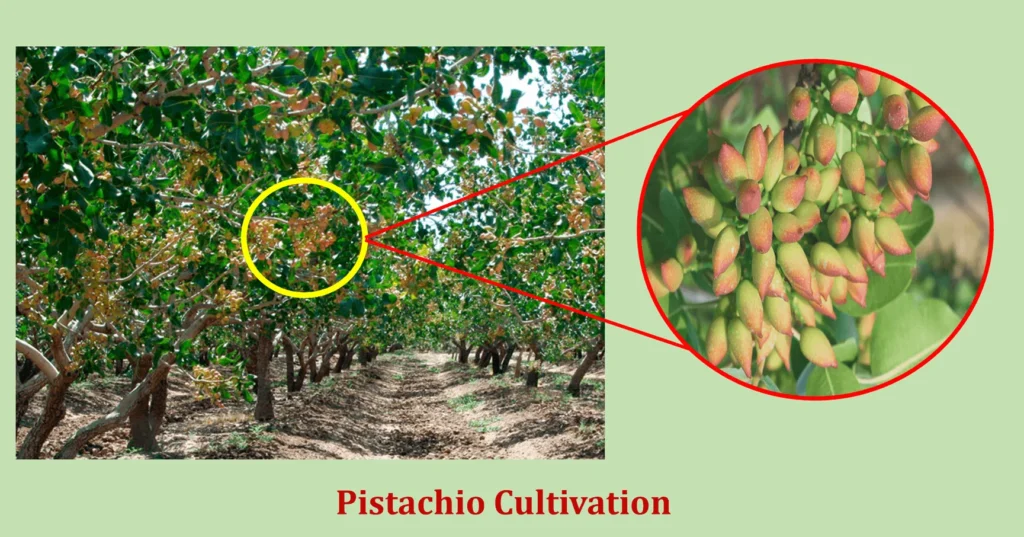
Water Consumption and Environmental Concerns
- Their cultivation requires significant water resources, particularly during the tree’s early years of growth and during the nut bearing stage.
- In regions with limited water availability, such as California’s Central Valley, concerns about water usage and environmental sustainability have prompted efforts to improve irrigation efficiency and reduce water consumption.
Sustainable Farming Practices in the Pistachio Industry
- Many growers are adopting sustainable farming practices to minimize their environmental impact and conserve natural resources.
- Sustainable practices may include drip irrigation systems, mulching to reduce evaporation, soil conservation techniques, and integrated pest management strategies to minimize pesticide use.
Impact of Pistachio Farming on Local Economies
Job Creation and Economic Development
- Its farming contributes to job creation and economic development in rural communities where its orchards are located.
- The cultivation, harvesting, processing, and distribution of this nut create employment opportunities for farm workers, agricultural technicians, and workers in processing facilities and distribution networks.
Social Responsibility Initiatives in Pistachio Farming Communities
- Many of their producers and processors engage in social responsibility initiatives aimed at supporting local communities and improving living conditions for farm workers.
- These initiatives may include providing access to education, healthcare, housing, and infrastructure development projects in their farming communities.
Challenges and Future Sustainability Efforts
- Despite progress in adopting sustainable practices, challenges remain in ensuring the long-term sustainability of their cultivation.
- Climate change, water scarcity, soil degradation, and pest management are among the ongoing challenges that their growers and researchers are addressing through innovation and collaboration.
- Future sustainability efforts may focus on increasing water efficiency, reducing carbon emissions, enhancing biodiversity, and promoting soil health to ensure the resilience and viability of their farming systems.
The sustainability and impact of environment on their cultivation are complex issues that require careful consideration of ecological, social, and economic factors. While they contribute to agricultural livelihoods and global food security, it’s essential to prioritize sustainable practices that minimize environmental degradation, conserve natural resources, and support the wellbeing of farming communities for generations to come.
Fun Facts and Trivia about Pistachios
Unusual Facts about Pistachios
- Ancient Symbolism: In ancient times, it was considered a symbol of wellness, happiness, and prosperity. They were often depicted in artwork and literature as a token of good fortune.
- Colorful Shells: They are unique among nuts because of their distinctive green and purple hues. The natural coloring of their shells is caused by the presence of antioxidants such as lutein and anthocyanins.
- Self-Cracking: They are one of the few nuts that naturally crack open when they reach maturity. This characteristic is known as “splitting” and makes them one of the easiest nuts to harvest.
Trivia Related to Pistachio Consumption and Culture
- Popular Snack: They are one of the oldest known nuts to be eaten by humans. They have been enjoyed as a snack for thousands of years and are a staple in many cuisines worldwide.
- Nutrient Rich Snack: They are not only delicious but also nutritious. They are rich in protein, fiber, healthy fats, vitamins, and minerals, making them a healthy snack choice.
- Versatile Ingredient: They are used in a wide range of culinary applications, from sweet desserts to savory dishes. They add a unique flavor and texture to salads, pastries, ice creams, and even savory sauces.
Quirky Anecdotes about Pistachios in History and Pop Culture
- Royal Treat: Legend has it that Queen Sheba of ancient Persia was particularly fond of pistachios and declared them to be a royal food, reserving the finest nuts for herself and her court.
- Pistachio Heist: In 2016, a group of thieves stole nearly $500,000 worth of these nuts from a processing plant in California. The stolen nuts were later recovered, but the incident gained widespread attention and earned the nickname “The Great Pistachio Heist.”
- Pop Culture References: They have made appearances in popular culture, from being mentioned in literature and music to being featured in movies and TV shows. They are often portrayed as a symbol of luxury, indulgence, and sophistication.
They are not only a delicious and nutritious snack but also a fascinating subject of cultural history and trivia. From their ancient symbolism to their modern-day popularity, they continue to captivate people’s imaginations and taste buds around the world. Whether enjoyed on their own or incorporated into culinary creations, they offer a delightful combination of flavor, texture, and intrigue.
Celebrating World Pistachio Day: Ideas and Activities
Hosting a Pistachio themed Party or Gathering
When hosting a themed party, you can truly immerse your guests in the wonderful world of this unique dry fruit. To create a perfect pistachio inspired ambiance, consider incorporating green and brown color schemes, use their shells as decorative elements, and even serve dishes that prominently feature this nutritious nut.
Get creative with your menu by including dishes like pistachio crusted salmon, pistachio pesto pasta, and decadent pistachio desserts. Don’t forget to offer snacks like pistachio nuts and pistachio ice cream to truly showcase the versatility of this flavorful nut.
Engage your guests with fun themed games and activities. From their shell crafts to their trivia quizzes, there are plenty of ways to entertain and educate your party attendees about their wonders.
Promoting Awareness and Giving Back
Show your support for their farmers and local businesses by purchasing pistachio products from small scale producers. By doing so, you can help sustain the industry based on these wonderful nuts and contribute to the livelihood of those who work tirelessly to bring these nutritious nuts to your table.
Consider donating these nuts related charities and organizations that strive to improve the lives of their farmers and their communities. Your contribution can make a significant impact on the wellbeing of those involved in their supply chain.
Share your favorite pistachio recipes and the health benefits of pistachios on social media platforms to spread awareness and encourage others to join their celebration. By sharing knowledge and resources, you can help more people discover the amazing health benefits of these nuts and incorporate them into their daily diet.
Conclusion & FAQs
Summary of the Main Ideas Covered in the Blog Post
Throughout this blog post, we’ve explored the multifaceted world of these magnificent nuts, from their rich history and cultural significance to their health benefits and culinary versatility. We’ve delved into the origins of their cultivation, discussed their impact on local economies, and highlighted the importance of sustainable farming practices. Additionally, we’ve shared fun facts, trivia, and quirky anecdotes about pistachios, showcasing their enduring appeal and fascination.
Final Thoughts on the Significance of Pistachios in Our Lives
They hold a special place in our hearts and kitchens, serving as a symbol of wellness, happiness, and prosperity throughout history. Not only are they a delicious and nutritious snack, but they also inspire creativity in the kitchen and bring people together through shared experiences and traditions. As we celebrate World Pistachio Day and savor the flavor of this beloved nut, let us appreciate its contributions to our lives and the world around us.
Invitation for Readers to Share Their Favorite Pistachio Recipes and Stories
We invite you, our readers, to join in the celebration of this dry fruit by sharing your favorite recipes, memories, and stories. Whether it’s a cherished family recipe passed down through generations or a creative culinary creation inspired by this dry fruit, we want to hear from you! Share your experiences and spread the joy with fellow enthusiasts around the globe.
Frequently asked questions (FAQs)
What is World Pistachio Day?
It is an annual celebration dedicated to honoring the delicious and nutritious nut. It’s a day to recognize the versatility, health benefits, and cultural significance around the world.
When is World Pistachio Day celebrated?
It is celebrated on February 26th every year.
Why do we celebrate World Pistachio Day?
It serves as an opportunity to raise awareness about the nutritional benefits, culinary uses, and sustainable farming practices associated with these nuts. It’s also a time to celebrate the rich history and cultural heritage of this beloved nut.
Are pistachios healthy for you?
Yes, they are considered a healthy snack option. They are packed with nutrients such as protein, fiber, healthy fats, vitamins, and minerals. Consuming them in moderation as part of a balanced diet can contribute to heart health, weight management, and overall wellbeing.
How can I incorporate them into my diet?
They can be incorporated into your diet in various ways. You can enjoy them as a standalone snack, add them to salads, yogurt, oatmeal, or cereal, include them in baking recipes such as cookies, cakes, and bread, or use them as a crunchy topping for savory dishes like salads, pasta, or roasted vegetables.
Are there any health benefits associated with eating them?
Yes, they offer numerous health benefits. They are rich in antioxidants, fiber, and healthy fats, which can contribute to heart health, aid in weight management, and help regulate blood sugar levels. They also contain essential nutrients such as vitamins B6 and E, potassium, and magnesium, which support overall health and wellbeing.
Are there any potential risks associated with consuming pistachios?
While they are generally safe for consumption, some individuals may have allergies to nuts, including them. It’s important to be mindful of any allergic reactions and consult a healthcare professional if you experience symptoms such as itching, swelling, or difficulty breathing after eating them.
Can pistachios be part of a weight loss diet?
Yes, they can be part of a weight loss diet when consumed in moderation. Despite being calorie dense, they are high in protein and fiber, which can help increase feelings of fullness and promote satiety. Incorporating them into a balanced diet and practicing portion control can support weight management goals.
